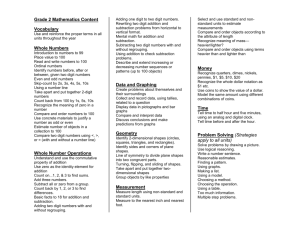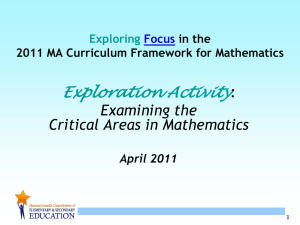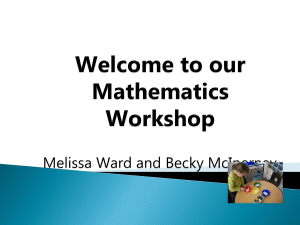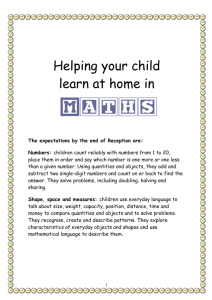Mental and Oral Starters - Counting and Number Sequences
advertisement
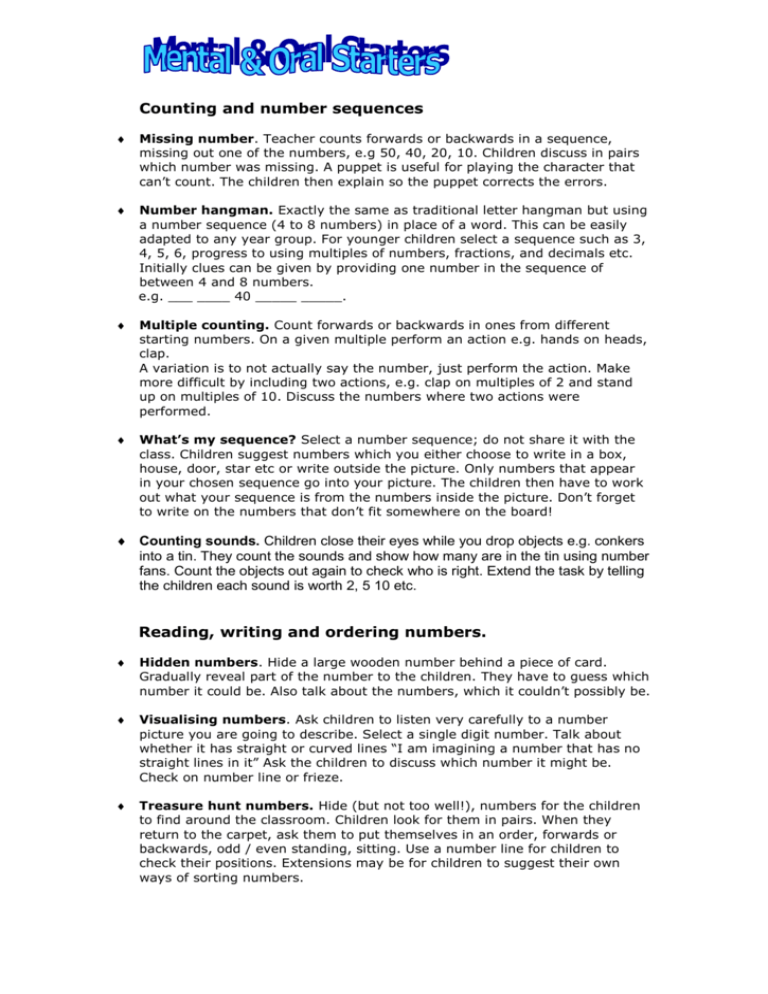
Counting and number sequences Missing number. Teacher counts forwards or backwards in a sequence, missing out one of the numbers, e.g 50, 40, 20, 10. Children discuss in pairs which number was missing. A puppet is useful for playing the character that can’t count. The children then explain so the puppet corrects the errors. Number hangman. Exactly the same as traditional letter hangman but using a number sequence (4 to 8 numbers) in place of a word. This can be easily adapted to any year group. For younger children select a sequence such as 3, 4, 5, 6, progress to using multiples of numbers, fractions, and decimals etc. Initially clues can be given by providing one number in the sequence of between 4 and 8 numbers. e.g. ___ ____ 40 _____ _____. Multiple counting. Count forwards or backwards in ones from different starting numbers. On a given multiple perform an action e.g. hands on heads, clap. A variation is to not actually say the number, just perform the action. Make more difficult by including two actions, e.g. clap on multiples of 2 and stand up on multiples of 10. Discuss the numbers where two actions were performed. What’s my sequence? Select a number sequence; do not share it with the class. Children suggest numbers which you either choose to write in a box, house, door, star etc or write outside the picture. Only numbers that appear in your chosen sequence go into your picture. The children then have to work out what your sequence is from the numbers inside the picture. Don’t forget to write on the numbers that don’t fit somewhere on the board! Counting sounds. Children close their eyes while you drop objects e.g. conkers into a tin. They count the sounds and show how many are in the tin using number fans. Count the objects out again to check who is right. Extend the task by telling the children each sound is worth 2, 5 10 etc. Reading, writing and ordering numbers. Hidden numbers. Hide a large wooden number behind a piece of card. Gradually reveal part of the number to the children. They have to guess which number it could be. Also talk about the numbers, which it couldn’t possibly be. Visualising numbers. Ask children to listen very carefully to a number picture you are going to describe. Select a single digit number. Talk about whether it has straight or curved lines “I am imagining a number that has no straight lines in it” Ask the children to discuss which number it might be. Check on number line or frieze. Treasure hunt numbers. Hide (but not too well!), numbers for the children to find around the classroom. Children look for them in pairs. When they return to the carpet, ask them to put themselves in an order, forwards or backwards, odd / even standing, sitting. Use a number line for children to check their positions. Extensions may be for children to suggest their own ways of sorting numbers. Swap shop. Children sit in a circle holding a number (include each number more than once). Teacher calls out a number and the children holding it have to swap places. Extend by saying different commands e.g. swap if your number is smaller than 4, swap if your number is one bigger than 6. Stand up, sit down. In pairs children write a number on a whiteboard or make with a number fan (you can limit the range of numbers or leave it open). You select a statement such as “more than 50”, “multiple of 12”, “less than half of 20”. Give children 5 seconds to discuss whether their number matches your statement. If so, when you say go, they stand up. Ask children to explain how they know their number fits the statement. Near or far. Select three different random digits. Children work in pairs. Teacher says a statement such as “close to 300”, “less than 200”, “close to quarter of a thousand”. Children then have to rearrange the digits and write their answer on a whiteboard. Discuss who is closest and why. This activity is easily differentiated by using two digit or four digit numbers and/or adjusting the statements you use Number facts and bonds Perfect partners. Make sets of cards with different pairs that total 100. (This total could be altered depending on year group. Please note, all pairs should add up to the same number!) Give out the cards randomly. Ask the children to find their “perfect partner”. Ask children to explain to the group how they knew their partner was the right one. Have large number lines or 100 squares visible for children to check their answers. Match me. Teacher holds up 2 digit cards e.g. 5 and 2. Children have to hold up 2 different cards with the same total as the teacher e.g. 3 and 4. Alter the task by asking children to hold up cards with the same difference or the same product. Facts bingo. This game can easily be altered for different year groups. Ask the children to select three numbers under 20 to write on a whiteboard. Teacher calls out a number and children may cross their number off if it is the other half of the pair totalling 20. E.g. teacher calls out 16. Children cross off 4 if they have it. This game can be altered to practice x tables. Children may write down three answers from a mutiplication table and the teacher calls out number statement e.g. “five multiplied by 3”, children would cross off 15 if they have it. The winner is the first one to cross off all their numbers. Play in pairs to promote discussion. Three in a row. Children (in pairs) draw a three by three grid on a whiteboard and choose multiples of 5 up to 100 to write in the spaces. Teacher calls out a multiple of 5 and children can cross off their answer if they have the other half of the pair totalling 100. The first pair to cross off 3 numbers in a row is the winners. Alter the numbers to practise other complements. Beans. Stick 7 beans to the board, some with the white side showing and some with the coloured. Children have to write down as many number sentences as they can to match the beans, e.g. 3 white beans and 4 coloured beans could be written 3+4=7, 4+3=7, 7=4+3, 7=3+4, 7-3=4, 7-4=3, 3=74, 4=7-3. Give children a set time to work and then collect and discuss answers. Number islands. Get two PE mats or hoops. Select a group of children e.g. 8 to come to the front. Ask the remaining children to find as many different ways of splitting the eight children between the two islands as possible, e.g. 6 and 2, 5 and 3. Don’t forget 8 and 0. You may wish to record their findings as number sentences to avoid repetition. Balloons. Draw 6 balloons on the board and in each one write a number e.g. 2, 3, 4, 6,12, 24. Give pairs of children three minutes to write down as many multiplication and division statements as they can using only the given numbers. Discuss the fact families i.e. if you know 62=12 then 26=12, 126=2 and 122=6. Remember to include examples with the equals sign in different positions. What else do you know? Write a number sentence on the board e.g. 5+2=7. Ask children which other facts they can derive from this one, e.g. 15+2=17, 50+20=70. Collect and discuss responses. Shape, space and measures Shape in my pocket. Put a shape in your pocket or a small bag. Children ask the teacher questions about that shape such as “Has it got any lines of symmetry?” “Has it got four sides?”, “Is it a regular shape?”. Write the answers to their questions on the board e.g. ‘This shape has four sides. The sides are all equal’ etc. After 5 questions, children discuss possible shapes it could be with a partner. Reveal the shape and recap its properties. Which measure? This can be adapted for use with time, weight, capacity or length. Write a selection of units on the board for the children to choose from e.g. mm, cm, m, Km. Give the children an example of something to be measured e.g. length of the playground, a pencil, height of the school. Children decide which unit of measurement they would select to measure with. This can be altered to ask the children which piece of measuring equipment they would select to measure with. Shape bingo. Children draw three shapes on a whiteboard. The teacher describes a property of a shape e.g. two lines of symmetry, no straight sides. Children can cross off their shape if it matches the teacher’s description. The first person to cross off all three shapes is the winner. Scales. Use a counting stick. Tell the children that one end is zero and the other end is one kilogram. Point to different intervals along the stick and ask children to estimate the amount you are pointing to. Alter the start or finish number and the units you are working with. To practise reading dials, use a foam counting stick that can be bent into a circle. Hidden shapes. Hide a shape behind a piece of card or in a large envelope. Reveal a small part of the shape and discuss shapes it could or couldn’t be. Don’t always use regular shapes! All squeeze in. Select a container e.g. a jug. Ask children to estimate how many cups of water they think will be needed to fill the jug. Count together. Vary the container e.g. how many cars will fit in the garage? Ladders. Children draw a ladder on a whiteboard with 5 spaces, which indicate 0-20cm, 21-40cm, 41-60cm, 61-80cm, 81-100cm. So the bottom of the ladder is zero and the top is one metre. Call out an amount e.g. 56cm and children have to decide where to place it on the ladder. Once an amount is placed it cannot be moved. The aim is for children to have all of the amounts in order. Extend the task by including amounts in decimals e.g. 0.87m. Odd one out. Draw 4 shapes on the board e.g. square, rectangle, trapezium and circle. Children discuss with a partner which shape is the odd one out and why. Mental strategies Which method? Produce a target board with addition sums (no answers). Point to a sum and children decide with their partner that would be the best strategy to use. You may wish to provide a list of strategies for the children to choose from. This can also be used with other operations. Easy adding. Produce a target board with a selection of two digit numbers. Ask children to discuss with their partner which two numbers they think are the easiest two to add together and why. Discuss answers as a class. Which are the hardest? Use with other operations. Hops to 100. Teacher writes a start number on the board. With a partner, children discuss how to reach 100 in two different hops (a hop being one mathematical operation) e.g. start number 15, subtract 5, multiply by 10. Make the task more difficult by introducing other rules; e.g. one of the operations must be division, by increasing the number of hops or by altering the ending number. It is important to discuss the different ways children have found. Share your secrets. Children talk with a partner about the best way to complete a calculation. Discus the most efficient methods as a class. Why am I wrong? This encourages estimation and checking. Write a number sentence on the board that is incorrect. Children discuss with a partner why it could not possibly be right. Older children could be encouraged to write an explanation. Share ideas as a class. E.g. 172=16x5. The children should spot that the product should be a multiple of 5 and that 172 is much too high.



